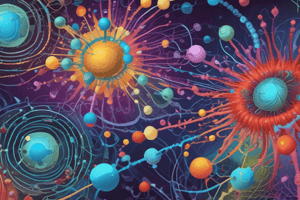Podcast
Questions and Answers
What is the main function of oxidoreductases?
What is the main function of oxidoreductases?
- Catalyzing reactions involving use of water molecules
- Catalyzing oxidation-reduction reactions (correct)
- Catalyzing reactions involving transfer of functional groups
- Catalyzing hydrolytic reactions
Which enzyme class is responsible for catalyzing reactions involving transfer of functional groups?
Which enzyme class is responsible for catalyzing reactions involving transfer of functional groups?
- Hydrolase
- Lyase
- Transferase (correct)
- Oxidoreductase
What is the primary characteristic of enzymes as catalysts?
What is the primary characteristic of enzymes as catalysts?
- They increase the rate of reaction without being changed themselves (correct)
- They are specific to only one type of reaction
- They are effective in larger quantities
- They change completely after the reaction
Which enzyme class catalyzes hydrolytic reactions involving the use of water molecules?
Which enzyme class catalyzes hydrolytic reactions involving the use of water molecules?
What is the function of hydrolases?
What is the function of hydrolases?
What type of enzyme catalyzes oxidation-reduction reactions by transferring electrons?
What type of enzyme catalyzes oxidation-reduction reactions by transferring electrons?
Which type of enzyme catalyzes cleavage of C-C, C-O, CN and other bonds by means other than hydrolysis or oxidation?
Which type of enzyme catalyzes cleavage of C-C, C-O, CN and other bonds by means other than hydrolysis or oxidation?
What is the function of isomerases?
What is the function of isomerases?
What is the function of ligases?
What is the function of ligases?
What is the primary structure of an enzyme?
What is the primary structure of an enzyme?
Which model proposes that the shape of the substrate and the active site of the enzyme fit together like a key into its lock?
Which model proposes that the shape of the substrate and the active site of the enzyme fit together like a key into its lock?
Who proposed the induced fit hypothesis for enzyme-substrate binding?
Who proposed the induced fit hypothesis for enzyme-substrate binding?
What are small, nonprotein units required by many enzymes to carry out their particular reaction?
What are small, nonprotein units required by many enzymes to carry out their particular reaction?
What is a complete catalytically-active enzyme together with its coenzyme or metal ion called?
What is a complete catalytically-active enzyme together with its coenzyme or metal ion called?
Which part of the enzyme on its own without its cofactor/ coenzyme is termed as apoenzyme?
Which part of the enzyme on its own without its cofactor/ coenzyme is termed as apoenzyme?
What is the region of the enzyme that binds the substrate, to form an enzyme–substrate complex, and transforms it into product called?
What is the region of the enzyme that binds the substrate, to form an enzyme–substrate complex, and transforms it into product called?
Flashcards are hidden until you start studying
Study Notes
Enzyme Functions and Characteristics
- Main Function of Oxidoreductases: Catalyze oxidation-reduction reactions by transferring electrons between molecules.
- Enzyme Class for Functional Group Transfer: Transferases are responsible for transferring functional groups from one molecule to another.
- Primary Characteristic of Enzymes: Enzymes act as catalysts, increasing the rate of reactions without being consumed in the process.
- Enzyme Class for Hydrolytic Reactions: Hydrolases catalyze reactions that involve the cleavage of chemical bonds through the addition of water.
Specific Enzyme Functions
- Function of Hydrolases: Facilitate breakdown of molecules by hydrolysis, such as the digestion of carbohydrates and proteins.
- Enzymes for Oxidation-Reduction Reactions: Oxidoreductases transfer electrons to facilitate oxidation and reduction processes.
- Enzymes for Cleavage of Bonds: Lyases catalyze the cleavage of C-C, C-O, CN, and other bonds using methods other than hydrolysis or oxidation.
- Function of Isomerases: Transform one isomer into another, rearranging the molecular structure without adding or removing any atoms.
- Function of Ligases: Catalyze the joining of two molecules by forming new chemical bonds, often utilizing ATP as an energy source.
Structural Characteristics of Enzymes
- Primary Structure of an Enzyme: Refers to the unique sequence of amino acids in the protein chain, determining its overall shape and function.
- Key-Lock Model: This model illustrates how the substrate fits precisely into the active site of the enzyme like a key fits into a lock.
- Induced Fit Hypothesis: Proposed by Daniel Koshland, this hypothesis suggests that the enzyme changes shape slightly to better fit the substrate during binding.
Enzyme Components
- Coenzymes and Metal Ions: Small, nonprotein units required by many enzymes for proper functioning in catalysis.
- Complete Catalytically-Active Enzyme: Known as a holoenzyme, it comprises the enzyme along with its coenzyme or metal ion.
- Apoenzyme: Refers to the enzyme without its cofactor or coenzyme, representing a non-functional form of the enzyme.
- Active Site: The specific region of the enzyme that binds the substrate and facilitates the conversion to product, forming an enzyme-substrate complex.
Studying That Suits You
Use AI to generate personalized quizzes and flashcards to suit your learning preferences.



